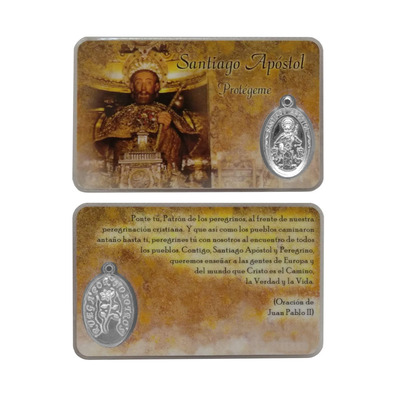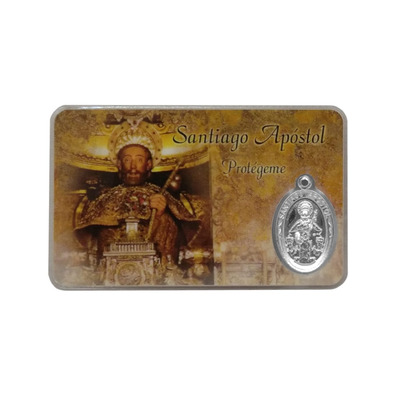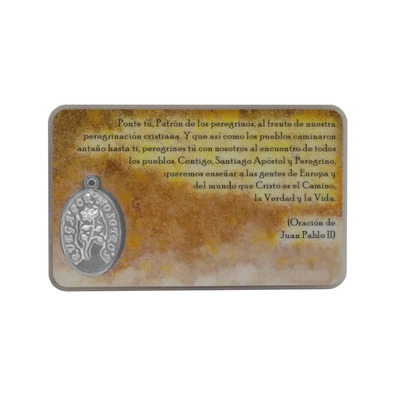Holy Card of St. James the Apostle
1,50€
Taxes includedCatholic product in stock. Products ready to be shipped. You can check the approximate delivery time during the purchase process.
Holy Card of St. James the Apostle | Figure from the Cathedral of Compostela
- Devotional holy card.
- 8.5 cm (3.35 in) wide.
- 5.5 cm (2.17 in) high.
- Laminated holy card.
- Includes a silver-plated metal medal with a raised image of St. James the Apostle.
- Back side features the prayer dedicated by John Paul II to St. James the Apostle.
Holy Card with the Image of St. James from the Cathedral of Compostela
The holy card is decorated with the figure of St. James the Apostle, which is located in the Cathedral of Compostela.
The figure of St. James the Apostle is found at the Main Altar of the Cathedral. It is one of the most iconic representations of the saint and a key reference point for the pilgrims of the Way of St. James.
The image of St. James the Apostle is a Gothic sculpture, made of polychrome stone. It depicts the saint as a pilgrim, dressed in a tunic and cloak, carrying the typical attributes of the Way of St. James: the staff, the gourd for water, and on his chest, the Cross of St. James.
One of the most significant traditions is the Embrace of the Apostle. Pilgrims ascend a staircase behind the main altar and embrace the statue of St. James the Apostle from behind as a sign of gratitude and devotion.
This gesture symbolizes the end of the Way of St. James and spiritual communion with the saint. It is a deeply emotional experience for travelers who have walked hundreds of kilometers to reach the cathedral. The effort, fatigue, and sacrifice they endured during their pilgrimage have been worth it. Finally, they meet the saint they came to see.
Besides the embrace, many pilgrims descend into the crypt, where the Tomb of St. James the Apostle is located. According to tradition, this tomb holds the remains of the apostle, discovered in the 9th century, which led to the construction of the Cathedral of Santiago de Compostela.
Another important tradition is the Pilgrim's Mass. During this Mass, travelers receive a special blessing in recognition of their effort. On special occasions, the Botafumeiro, a giant censer, is used, swinging through the central nave, filling the cathedral with the scent of incense and offering an impressive visual spectacle.
Prayer from the Holy Card of St. James the Apostle
The back of the devotional holy card is decorated with a prayer dedicated to St. James the Apostle. The prayer is an adaptation of the last two verses of the prayer that John Paul II dedicated to St. James the Apostle in 1989.
This papal prayer was one of the most memorable moments of the supreme pontiff’s visit to the city of Compostela in August 1989.
The Pope’s journey was part of the activities held for the celebration of the IV World Youth Days.
History of St. James the Apostle
St. James the Apostle, also known as James the Greater, was one of Jesus' closest disciples. He witnessed key moments such as the Transfiguration and the Agony in the Garden of Gethsemane.
He was born in Bethsaida, Galilee, and was the son of Zebedee and the brother of John the Evangelist.
Before being called by Jesus, he worked as a fisherman.
The Apostle James had a strong character, which earned him the nickname "Son of Thunder."
Evangelization and Our Lady of the Pillar
According to tradition, after Christ’s death, St. James the Apostle, following his Master’s instructions, traveled to Hispania to preach the Gospel.
His first destination was Gallaecia, the land of the Gallaeci and Astures. Despite his faith and effort, he had little success; the people did not understand Jesus' message.
Eventually, he decided to continue elsewhere and traveled north to Caesaraugusta, now Zaragoza. Without losing hope, he began his work and managed to convert eight men to Christianity, a significant achievement.
After this great initial success, his faith began to waver. As he struggled to spread the Word of the Lord, the Virgin Mary appeared to him on a column (a pillar), an event that gave rise to the devotion to Our Lady of the Pillar.
The Virgin Mary encouraged him and asked him to build a chapel around the pillar. Before completing the construction, St. James consecrated it as St. Mary of the Pillar, the first church dedicated to the Virgin Mary.
This primitive temple became the foundation for the evangelization of Western Europe and, over time, would become the Basilica of Our Lady of the Pillar, where the pillar with the Virgin’s image remains.
After a long time, he decided to return to Judea. Upon his arrival, he was arrested and beheaded by order of Herod Agrippa I in 44 A.D., becoming the first apostolic martyr.
After his death, his disciples transported his remains by sea to Iria Flavia (Galicia). His remains were placed in the land where he had been evangelizing.
In the 9th century, his tomb was discovered and identified as that of St. James the Apostle. This led to the construction of the Cathedral of Santiago de Compostela.
The discovery of the tomb boosted Catholic pilgrimage. The Way of St. James became one of the most important pilgrimage routes in Christianity, attracting pilgrims from all over the world.
St. James the Apostle, Patron of Spain
St. James the Apostle is the patron saint of Spain and Galicia. He is also considered the protector of pilgrims, knights, and soldiers.
His feast day is celebrated every July 25. This date commemorates his martyrdom and is one of the most important religious and cultural celebrations in Spain.
July 25 is also Galicia Day, a date of great popular tradition where the typical products and traditions of the Galician community are honored.








